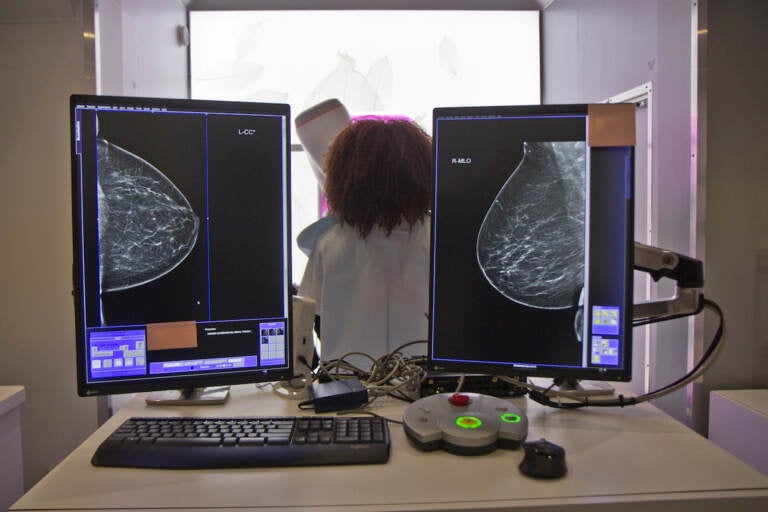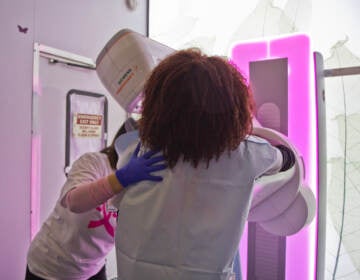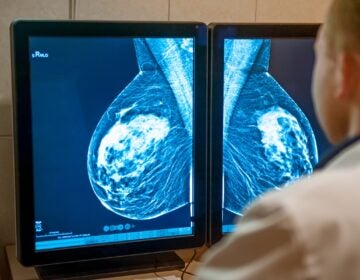Delaware study finds breast cancer hotspots, linking low screenings and aggressive tumors to late-stage diagnoses
Using data from 3,492 patients, a ChristianaCare study found breast cancer hotspots in Wilmington and Middletown.
Listen 1:28
Staff of Penn Medicine’s mobile mammography unit demonstrate how patients receive a mammogram on Oct. 22, 2021 in Philadelphia. (Kimberly Paynter/WHYY)
From Philly and the Pa. suburbs to South Jersey and Delaware, what would you like WHYY News to cover? Let us know!
Delaware’s fight against breast cancer has taken a sharper, more targeted turn.
A study released in July by ChristianaCare’s Cawley Center for Translational Cancer Research identified two neighborhoods in New Castle County where women are significantly more likely to be diagnosed with late-stage breast cancer.
The research drew on patient data from the cancer registry at the Helen F. Graham Cancer Center and Research Institute, which identified 3,492 women diagnosed with invasive breast cancer between 2012 and 2020.
For years, the state has grappled with higher-than-average rates of aggressive breast cancers, particularly among younger women. Now, researchers say they not only know where the most urgent risks are — they also have a plan to reduce them.
“This study is the most recent research we’ve conducted in a line of studies that has been seeking to better understand why Delaware has some concerning breast cancer trends,” said Scott Siegel, director of Cancer Control and Population Sciences at ChristianaCare. “We see higher rates of more aggressive forms of cancer, higher rates of more late-stage breast cancer, particularly among younger women.”
Breaking down the data, pinpointing the communities
The study builds on earlier studies mapping “hotspots” – neighborhoods where the rates of advanced breast cancer are higher than statistically expected.
“This study was really about understanding what’s driving those hotspots, what seems to be causing those higher rates in those communities, so that we could develop more effective community-based interventions,” he said.
Researchers found two primary factors behind these elevated rates: fewer women in certain communities getting regular screening mammograms, and a higher prevalence of aggressive tumor types such as triple-negative breast cancer.
“The communities with higher rates of more advanced breast cancer were less likely to have a good uptake of breast cancer screening or screening mammography,” he said. “The second factor was tumor biology. So in areas where we saw higher rates of more aggressive forms of breast cancer, notably a subtype called triple-negative breast cancer, were also areas where we were more likely to see breast cancer diagnosed at an advanced stage.”
When both of these occur together, Siegel said the result is clear.
“It was the hotspots that were really the confluence of both of those factors operating at the same time,” Siegel said. “Communities where you saw both higher rates of more aggressive disease and at the same time lower rates of screening were the places that really popped out as the hotspots.”
The research pinpointed two areas in New Castle County: the Riverside community in northeast Wilmington and Middletown, both of which saw similar trends where rates of advanced breast cancer were higher than expected, particularly among women under 50.
These findings weren’t visible using traditional public health mapping, which required more unique detection solutions, Siegel said.
“These hotspots prior to our research were not known about,” he explained. “We’re using a much more precise approach. It’s a method called spatial intensity … We can get fairly precise down to the area of several city blocks, for example, which is very helpful because it allows us to focus in a targeted way on those parts of the community that are most in need.”
Understanding the barriers, what now?
In Riverside, historic inequities have made it harder for residents to access preventative care. And while Middletown has more resources to connect residents to care, rapid growth can explain its risk.
“There have been historic issues related to access to care and also, for example, access to healthy food or an overabundance of liquor stores,” Siegel said. “It’s important to note that Middletown has shown really profound growth over the last 20 years. And so one hypothesis we have is that as that population has grown, has the access to health care kept pace.”
ChristianaCare has already embedded a community health worker in Riverside to raise awareness and connect women to screening services.
“What she’s doing is raising awareness, educating the community about the risk, making them aware that there are things we can do to prevent breast cancer and then helping connect them to those resources and healthcare services, including screening and other ways to reduce risk,” he said.
“There is nothing inevitable about this. We can definitely get ahead of this. And now we know where to focus, and we have the resources embedded,” he added.
Looking ahead, beyond New Castle County
While this study focused on northern Delaware, researchers are already in the middle of identifying other high-risk areas farther south.
“We are actively working on that,” he said. “While we’re not yet ready to release those results … there are areas of concern in Kent and Sussex. And they may look different. We’re talking about areas that are more rural, more dispersed. It’s different kinds of challenges, but yeah, we expect that we’ll be sharing those results … that there are going to be other communities in Kent and Sussex that we’re going to want to focus on as well.”
Siegel pointed to Delaware’s proven record in reversing cancer trends – from lowering overall cancer mortality rates to reducing colorectal cancer cases – as proof the state can do the same for breast cancer. His message to the public: be proactive and take the screenings.

Get daily updates from WHYY News!
WHYY is your source for fact-based, in-depth journalism and information. As a nonprofit organization, we rely on financial support from readers like you. Please give today.






